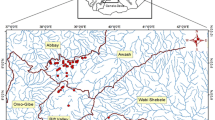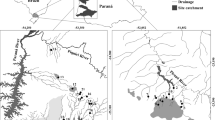Abstract
Within the ecological assessment of running waters based on benthic macroinvertebrates different levels of taxonomic resolution (species, genus, family and higher) are in use. Although assessment systems are often developed with detailed data on species level, water managers and other end-users could like to use data on higher taxonomic levels to assess the ecological quality of a water body because of limited human or money resources. The question that arises is, if an assessment system built with species level data is also applicable using data with a higher taxonomic resolution.
Within the AQEM project a multimetric assessment system was developed to evaluate the ecological quality classes (from bad (1) to high (5) ecological quality) of different stream types throughout Europe. The present study focuses on the question whether the resulting water quality class changes using the AQEM Assessment Software (AAS) with different taxonomic resolutions and if yes, how large the deviations of ecological quality classes from the original classes are and if the deviations are unidirectional. For analyses data from four Austrian and two Dutch stream types were used.
It is demonstrated that the assignment of a site to an ecological quality class may change if different taxonomic levels are used. Deviations in both directions (higher/lower ecological quality class) were observed. In most cases the divergence was only one ecological quality class, but also larger deviations occasionally occurred. The causes of changes in the assessment were investigated by separately looking into the underlying metrics of the multimetric system. Some of the evaluated metrics rely on autecological information on species level and are simply not applicable on higher taxonomic levels. Other metrics worked on higher taxonomic levels as well and showed more or less good distinctions between ecological quality classes.
It is concluded that the AQEM Assessment Software is not applicable if data on higher taxonomic levels are used. As the deviations were not unidirectional and ranged from one to three ecological quality classes, it is not possible to include a correction factor for using the software with higher taxonomic resolution data.
Similar content being viewed by others
References
AQEM Consortium, 2002. Manual for the application of the AQEM system. A comprehensive method to assess European streams using benthic macroinvertebrates, developed for the purpose of the Water Framework Directive. Version 1.0 (www.aqem.de), February 2002, 202 pp.
Armitage, P. D., D. Moss, J. F. Wright & M. T. Furse, 1983. The performance of a new biological water quality scores system based on macroinvertebrates over a wide range of unpolluted running-water sites. Water Res. 17: 333–347.
Austrian Standards, 1995. ÖNORM M 6232. Richtlinien für die ökologische Untersuchung und Bewertung von Fließgewässern, 82 pp.
Bailey, R. C., R. H. Norris & T. B. Reynoldson, 2001. Taxonomic resolution of benthic macroinvertebrate communities in bioassessments. J. N. Am. Benthol. Soc. 20: 250–286.
Barbour, M. T., J. B. Stribling & J. R. Karr. 1995. The multimetric approach for establishing biocriteria and measuring biological condition. In Davis, W. & T. Simon (eds), Biological Assessment and Criteria: Tools for Water Resource Planning and Decisionmaking. Lewis Publishers, Michigan: 63–76.
Bohle, H. W., 1983. Driftfang und Nahrungserwerb der Larven von Drusus discolor (Trichoptera, Limnephilidae). Arch. Hydrobiol. 97/4: 455–470.
Bournaud, M., B. Cellot, P. Richoux & A. Berrahou, 1996. Macroinvertebrate community structure and environmental characteristics along a large river: congruity of patterns for identification to species or family. J. N. Am. Benthol. Soc. 15(2): 232–253.
Bowman, M. F. & R. C. Bailey, 1997. Does taxonomic resolution affect the multivariate description of the structure of freshwater benthic macroinvertebrate communities? Can. J. Fish. aquat. Sci. 54: 1802–1807.
Brabec, K., S. Zahrádková, D. Němejcová, P. Pařil, J. Kokeš, J. Jarkovský, 2004. Assessment of organic pollution effect considering differences between lotic and lentic stream habitats. Hydrobiologia 516: 331–346.
Buffagni, A., S. Erba, M. Cazzola & J. L. Kemp, 2004. The AQEM multimetric system for the southern Italian Apennines: assessing the impact of water quality and habitat degradation on pool macroinvertebrates in Mediterranean rivers. Hydrobiologia 516: 313–329.
Chessman, B. C., 1995. Rapid assessment of rivers using macroinvertebrates: a procedure based on habitat-specific sampling, family level identification and a biotic index. Aust. J. Ecol. 20: 122–129.
Dolédec, S., J. M. Olivier & B. Statzner, 2000. Accurate description of the abundance of taxa and their biological traits in stream invertebrate communities: effects of taxonomic and spatial resolution. Arch. Hydrobiol. 148/1: 25–43.
European Commission, 2000. Directive 2000/60/EC of the European Parliament and of the Council. Establishing a framework for Community action in the field of water policy.
Furse, M. T., D. Moss, J. F. Wright & P. D. Armitage, 1984. The influence of seasonal and taxonomic factors on ordination and classification of running-water sites in Great Britain and on the prediction of their macroinvertebrate communities. Freshwat. Biol. 14: 257–280.
Gerritsen, J., 1995. Additive biological indices for resource management. J. N. Am. Benthol. Soc. 14: 451–457.
Graça, M. A. S., C. N. Coimbra & L. M. Santos, 1995. Identification level and comparison of biological indicators in biomonitoring programs. Ciênc. Biol. Ecol. Syst. 15: 9–20.
Graf, W., U. Grasser & J. Waringer, 1995. Trichoptera. In Moog, O. (ed.), Fauna Aquatica Austriaca-A Comprehensive Species Inventory of Austrian Aquatic Organisms with Ecological Notes. Federal Ministry for Agriculture and Forestry, Wasserwirtschaftskataster Vienna: loose-leaf binder.
Graf, W., U. Grasser & O. Moog, 1992. The role of Allogamus auricollis (Trichoptera: Limnephilidae) in benthic communities of a 4th-order crystalline mountain stream with some ecological notes. Proc. 7th Symp. Trichoptera, Umea, Sweden: 297–303.
Hawkins, C. P. & M. P. Vinson, 2000. Weak correspondence between landscape classifications and stream invertebrate assemblages: implications for bioassessment. J. N. Am. Benthol. Soc. 19: 501–517.
Hawkins, C. P. & R. H. Norris, 2000. Effects of taxonomic resolution and use of the subsets of the fauna on the performance of RIVPACS-type models. In Wright, J. F., D.W. Sutcliffe & M. T. Furse (eds), Assessing the Biological Quality of Fresh Waters. RIVPACS and Other Techniques. Freshwater Biological Association 217–228.
Hawkins, C. P., R. H. Norris, J. N. Hogue & J. W. Feminella, 2000. Development and evaluation of predictive models for measuring the biological integrity of streams. Ecol. Appl. 10: 1456–1477.
Hering, D., O. Moog, L. Sandin & P. F. M. Verdonschot, 2004. Overview and application of the AQEM assessment system. Hydrobiologia 516: 1–20.
Hewlett, R., 2000. Implications of taxonomic resolution and sample habitat for stream classification at a broad geographic scale. J. N. Am. Benthol. Soc. 19: 352–361.
Karr, J. R. 1991. Biological integrity: A long-neglected aspect of water resource management. Ecol. Appl. 1: 66–84.
Karr, J. R. & E. W. Chu, 1999. Restoring Life in Running Waters: Better Biological Monitoring. Island Press, Washington D.C., 206 pp.
King, R. S. & C. J. Richardson, 2002. Evaluating subsampling approaches and macroinvertebrate taxonomic resolution for wetland bioassessment. J. N. Am. Benthol. Soc. 21(1): 150–171.
Koller-Kreimel, V., O. Moog, A. Schernhammer & I. Stubauer, 1997. Quantifizierung der Unschärfe familienbezogener Gewässergüte-Beurteilungsmethoden. 32. Konferenz der IAD Wien. Ergänzungen zu Band I: 229–236.
Lenat, D. R. & V. H. Resh, 2001. Taxonomy and stream ecology-The benefits of genus-and species-level identifications. J. N. Am. Benthol. Soc. 20(2): 287–298.
Major, E. B., B. K. Jessup, A. Prussian & D. Rinella, 2001. Alaska Stream Condition Index: Biological Index Development for Cook Inlet 1997–2000 Summary. Alaska Department of Environmental Conservation.
Marchant, R., 1990. Robustness of classification and ordination techniques applied to macroinvertebrate communities from La Trobe River, Victoria. Aust. J. Mar. Freshwat. Res. 41: 493–504.
Marchant, R., L. A. Barmuta & B. C. Chessman, 1995. Influence of sample quantification and taxonomical resolution on the ordination of macroinvertebrate communities from running waters in Victoria. Austr. J. Mar. Freshwat. Res. 46: 501–506.
Margalef, R., 1958. Information theory in ecology. Entomol. Syst. 3: 36–71.
Metzeling, L. & J. Miller, 2001. Evaluation of the sample size used for the rapid bioassessment of rivers using macroinvertebrates. Hydrobiologia 444: 159–170.
Moog, O. (ed.), 1995. Fauna Aquatica Austriaca-A Comprehensive Species Inventory of Austrian Aquatic Organisms with Ecological Notes. Federal Ministry for Agriculture and Forestry, Wasserwirtschaftskataster Vienna: loose-leaf binder.
Moog, O., E. Bauernfeind & P. Weichselbaumer, 1997. The use of Ephemeroptera as saprobic indicators in Austria. In Landolt, P. & M. Sartori (eds), Ephemeroptera & Plecoptera: Biology-Ecology-Systematics. Fribourg: 254–260.
Ofenböck, T., O. Moog, J. Gerritsen & M. T. Barbour, 2002. Multimetrische Methoden zur Charakteristik des 'ökologischen Zustandes' gemäß EU-Wasserrahmenrichtlinie. DGL, Tagungsbericht der Jahrestagung 2001.
Ofenböck, T., O. Moog, J. Gerritsen & M. Barbour, 2004. A stressor specific multimetric approach for monitoring running waters in Austria using benthic macro-invertebrates. Hydrobiologia 516: 251–268.
Reece, P. F., T. B. Reynoldson, J. S. Richardson & D. M. Rosenberg, 2001. Implications of seasonal variation for biomonitoring with predictive models in the Fraser River catchment, British Columbia. Can. J. Fish. aquat. Sci. 58: 1411–1418.
Resh, V. H. & E. P. McElravy, 1993. Contemporary quantitative approaches to biomonitoring using benthic macroinvertebrates. In Rosenberg, D. M. & V. H. Resh (eds), Freshwater Biomonitoring and Benthic Macroinvertebrates. Chapman & Hall, New York: 159–194.
Resh, V. H. & J. D. Unzicker, 1975. Water quality monitoring and aquatic organisms: the importance of species identification. J. Wat. Poll. Fed. 47: 9–19.
Rosenberg, D. M. & V. H. Resh (eds), 1993. Freshwater Biomonitoring and Benthic Macroinvertebrates. Chapman & Hall, New York.
Sandin, L., J. Dahl & R. K. Johnson, 2004. Assessing acid stress in Swedish boreal and alpine streams using benthic macroinvertebrates. Hydrobiologia 516: 129–148.
Schweder, H., 1992. Neue Indices für die Bewertung des ökologischen Zustandes von Fließgewässern, abgeleitet aus der Makroinvertebraten-Ernährungstypologie. Limnol. Aktuell 3: 353–377.
Shannon, C. E. & W. Weaver, 1949. The Mathematical Theory of Communication. The University of Illinois Press, Urbana, IL.
Simpson, E. H., 1949. Measurement of diversity. Nature 163: 688.
StatSoft, Inc. (2000). STATISTICA for Windows [Computer program manual]. Tulsa, OK. Web: http://www.statsoft.com.
Statzner, B., V. H. Resh & S. Dolédec (eds), 1994. Ecology of the Upper Rhône River: a test of habitat templet theories. Freshwat. Biol. 31: 253–554.
Stubauer, I. & O. Moog, 1996. Gütebeurteilung österreichischer Fließgewässer mittels BMWP/ASPT-ein Methodenvergleich mit dem Saprobiensystem. Deutsche Gesellschaft f. Limnologie (DGL), Tagungsbericht 1995: 622–626.
Stubauer, I. & O. Moog, 2000. Taxonomic sufficiency versus need for information-comments on Austrian experience in biological water quality monitoring. Verh. Int. Verein. Limnol. 27: 2562–2566.
Townsend, C. R. & A. G. Hildrew, 1994. Species traits in relation to a habitat templet for river systems. Freshwat. Biol. 31: 265–275.
Usseglio-Polatera, P., M. Bournaud, P. Richoux & H. Tachet, 2000. Biomonitoring through biological traits of benthic macroinvertebrates: how to use species traits databases? In Jungwirth, M., S. Muhar & S. Schmutz (eds), Assessing the Ecological Integrity of Running Waters. Hydrobiologia 422/423: 153–162.
Verdonschot, P. F. M., 2000. Integrated ecological assessment methods as a basis for sustainable catchment management. In: Jungwirth, M., S. Muhar & S. Schmutz (eds), Assessing the Ecological Integrity of Running Waters. Hydrobiologia 422/423: 389–412.
Vlek, H. E., P. F. M. Verdonschot & R. C. Nijboer, 2004. Towards a multimetric index for the assessment of Dutch steams using benthic macroinvertebrates. Hydrobiologia 516: 173–189.
Waite, I. R., A. T. Herlihy, D. P. Larsen & D. J. Klemm, 2000. Comparing strengths of geographic and non-geographic classifications of stream benthic macroinvertebrates in the Mid-Atlantic Highlands, USA. J. N. Am. Benthol. Soc. 19(3): 429–441.
Warwick, R. M., 1988. The level of taxonomic discrimination required to detect pollution effects on marine benthic communities. Mar. Ecol. Prog. Ser. 19: 259–268.
Warwick, R. M., 1993. Environmental impact studies on marine communities: pragmatical considerations. Aust. J. Ecol. 18: 63–80.
Wright, J. F., 2000. An introduction to RIVPACS. In Wright, J. F., D. W. Sutcliffe & M. T. Furse (eds), Assessing the Biological Quality of Fresh Waters. RIVPACS and Other Techniques. Freshwater Biological Association: 1–24.
Zamora-Muñoz, C. & J. Alba-Tercedor, 1996. Bioassessment of organically polluted Spanish rivers, using a biotic index and multivariate methods. J. N. Am. Benthol. Soc. 15: 332–352.
Author information
Authors and Affiliations
Rights and permissions
About this article
Cite this article
Schmidt-Kloiber, A., Nijboer, R.C. The effect of taxonomic resolution on the assessment of ecological water quality classes. Hydrobiologia 516, 269–283 (2004). https://doi.org/10.1023/B:HYDR.0000025270.10807.10
Issue Date:
DOI: https://doi.org/10.1023/B:HYDR.0000025270.10807.10




